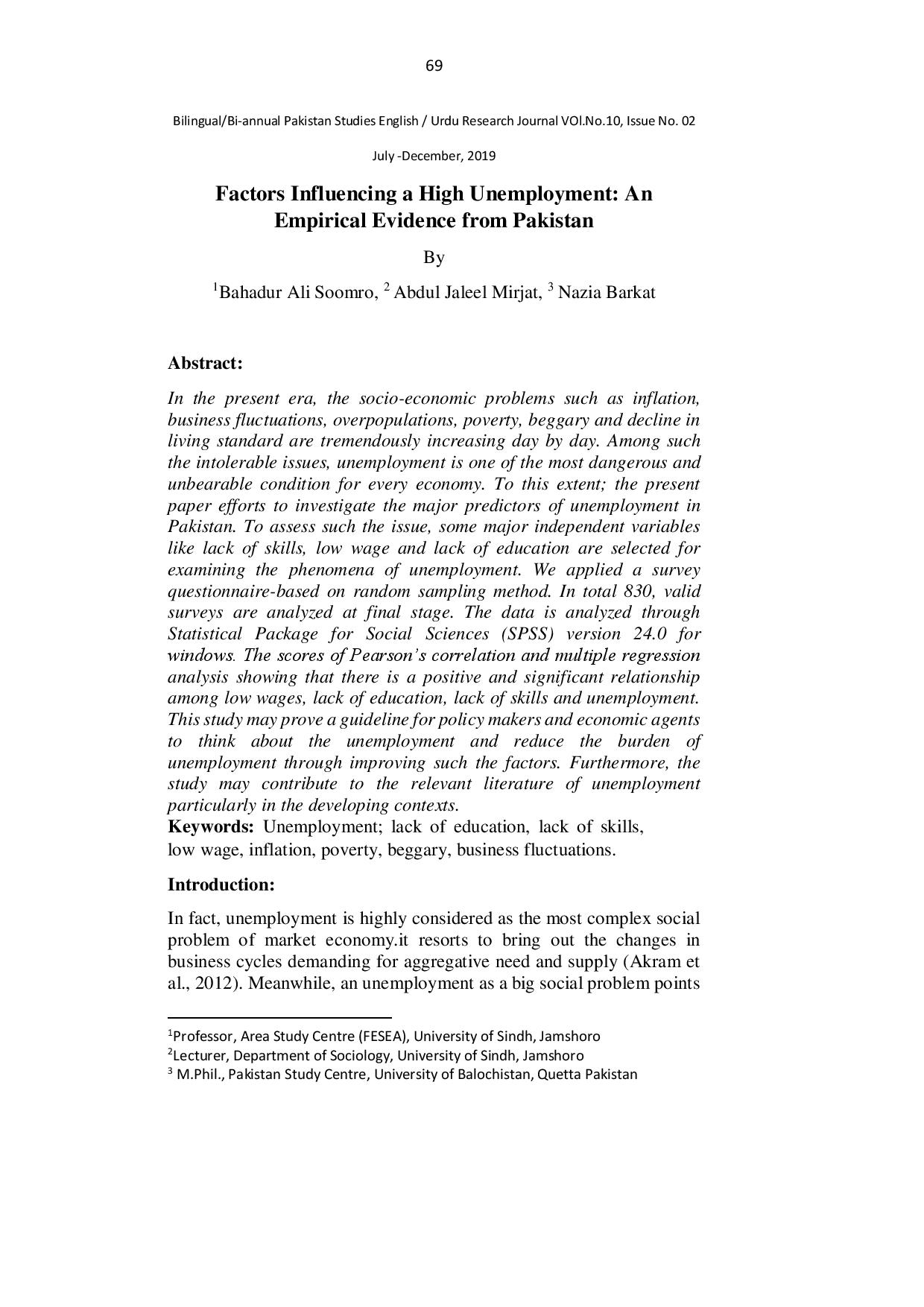Factors Influencing a High Unemployment An Empirical Evidence from Pakistan
Keywords:
Unemployment; lack of education, lack of skills, low wage, inflation, poverty, beggary, business fluctuations.Abstract
In the present era, the socio-economic problems such as inflation,
business fluctuations, overpopulations, poverty, beggary and decline in
living standard are tremendously increasing day by day. Among such
the intolerable issues, unemployment is one of the most dangerous and
unbearable condition for every economy. To this extent; the present
paper efforts to investigate the major predictors of unemployment in
Pakistan. To assess such the issue, some major independent variables
like lack of skills, low wage and lack of education are selected for
examining the phenomena of unemployment. We applied a survey
questionnaire-based on random sampling method. In total 830, valid
surveys are analyzed at final stage. The data is analyzed through
Statistical Package for Social Sciences (SPSS) version 24.0 for
windows. The scores of Pearson’s correlation and multiple regression
analysis showing that there is a positive and significant relationship
among low wages, lack of education, lack of skills and unemployment.
This study may prove a guideline for policy makers and economic agents
to think about the unemployment and reduce the burden of
unemployment through improving such the factors. Furthermore, the
study may contribute to the relevant literature of unemployment
particularly in the developing context
References
Akhtar, I. and Ozturk, L. (2009), “Can unemployment be cured by
economic growth and foreign direct investment in Turkey?”
International Research Journal of Finance and Economics, Vol.
, pp. 203-211.
Akram, S., Khan, S., Khan, M. N. and Muhammad Tufail, M. (2012),
“Unemployment Reasons and Its Impact on Pakistan Economy”,
City University Research Journal, Vol. 3, No.1, pp. 204-216.
Andrew, M. and Nickell, S. (1982), “Unemployment in the United
Kingdom since the War”, Review of Economic Studies, Vol. 49,
pp.731-759.
Aslam, M. (2010), “Poverty in Pakistan”, Economic survey. Islamabad:
Economic adviser wing, finance division, Government of
Pakistan. 127-128.
Asliddin, N. and Gharleghi, B. (2015), “Factors influencing high
unemployment in Tajikistan, “International Journal of Social
Science Studies, Vol. 3, No. 6, pp. 49-56.
Berentsen, A. Menzio, G. Wright, R. (2011), “Inflation and
unemployment in the long run: American Economic Review”,
American Economic Association, Vol. 101, No. 1, pp.371-98.
Cartmel, F. and Furlong, A. (2000), “Youth unemployment in rural
areas”, Report No: 220, Produced for The Joseph Rowmtree
Foundation.
Chaudhary, M. and Hamid, A. (1998), “Unemployment in Pakistan.
Pakistan Economic and Social Review, Vo. 36, No. 2, pp.147-
Eita, J. H. and Ashipala, J. M (2010), “Determinants of unemployment
in Pakistan”, International Journal of Business and
Management, Vol. 5, No. 10, pp.92-104.
Emst, E. (2011), “Determinants of unemployment flows, labour market
institutions and macroeconomic policies”, Discussion paper,
International Institute for Labour Studies.
Faridi, M. Z., Malik, S. and Ahmed, R. I (2010), “Impact of education
and health on employment in Pakistan: A case Study”, European
Journal of Economics, Finance and Administrative Sciences,
Vol. 18, pp.58-68.
Hunt, J. (1999), “Determinants of non-employment and unemployment
durations in east Germany”, CEPR Discussion Papers 2182,
C.E.P.R. Discussion Papers.
ILO's World Employment Report (2001), “ILO's World Employment
Report 2001: Despite Improved Employment Outlook, Digital
Divide Looms Large”, www.ilo.org/global/about-theilo/newsroom/news/WCMS_007830/.../index.htm.
International Monetary Fund (IMF) (1998), “Unemployment dynamics
during recessions and recoveries: okun’s law and beyond”,
www.imf.org/external/pubs/ft/weo/2010/01/pdf/c3.pdf.
Khan, S. R., Ali, S. Z., and Malik, S. J. (1986), “Some findings about
the unemployed highly educated persons in Pakistan”, The
Pakistan Development Review, Vol. 25, No. 4, pp.731-736.
https://www.statista.com/statistics/383735/unemployment-ratein-pakistan/
Pakistan Economic Survey (2010-2011), page 151.
Puspadjuita, E. A. R. (2018), “Factors that Influence the rate of
unemployment in Indonesia”, International Journal of
Economics and Finance, Vol. 10, No. 1, pp. 140-147.
Qayyum, W. (2007), “Causes of youth unemployment in Pakistan”, The
Pakistan Development Review, Vol. 46, No. 4, pp.611-621.
Rafiq, M., Ahmad I. and Ullah, A. (2010), “Determinants of
unemployment: A case study of Pakistan economy (1998-
”, Abasyn Journal of Social Sciences, Vol. 3, No. 1, pp.17-
Rocha, C. H. and Jose, A. (2002), “The determinants of unemployment
in Brazil and Mexico”, Economia, Vol. 3, No. 2, pp. 303-315.
Saeed, N. M. (2002), “Economics of Pakistan”, Imtiaz Book Depot,
page 121-123.



